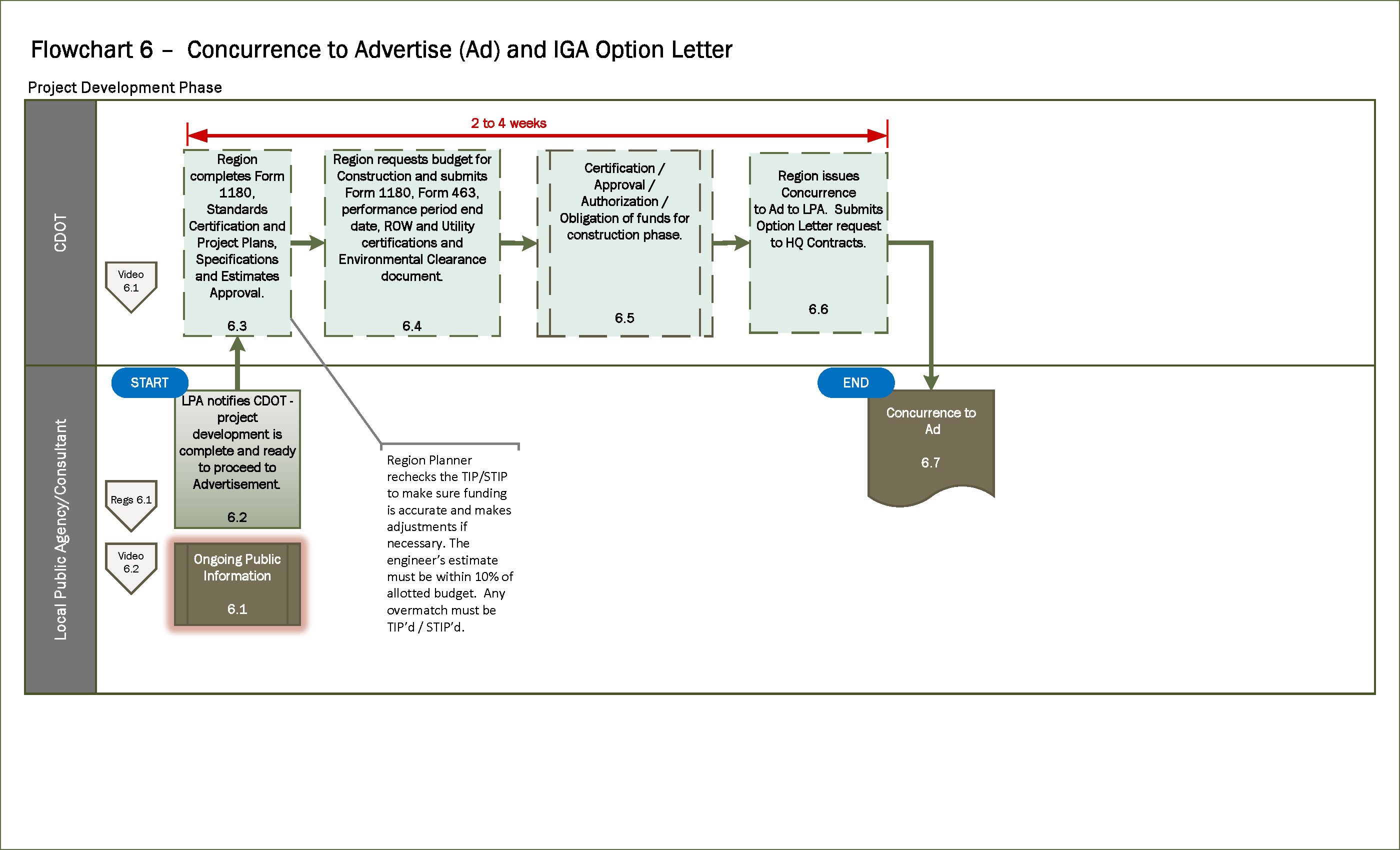Flowchart 6: Concurrence to Advertise (Ad) and IGA Option Letter

Caption: Flowchart 6 process flowchart outlining the roles for the Local Public Agencies and the Colorado Department of Transportation. Details and information provided in this flowchart image is outlined below.
Download Flowchart 6 (PDF) Download the Flowchart 6 Checklist
Flowchart 6 Project Development Phase Information
- It is recommended that you involve the public throughout project development and especially prior to the start of the construction phase. Project information can be provided via flyers, news releases, or your agency website. You may use CDOT's Public Participation Guidelines, or adopt your own.
- You should coordinate with CDOT to determine whether there are disproportionately adverse impacts to minority and low income populations. For guidance contact your CDOT project manager or visit CDOT's site on environmental justice.
- When a significant number or proportion of the affected community needs information in a language other than English to participate in the process, you must provide notices of public meetings and project information in the other languages and take any other reasonable steps, including providing an interpreter, appropriate for the scope of the program and the size and concentration of the limited English proficiency population.
- Public meetings can include door to door visits, homeowner group meetings, business surveys, stakeholder meetings, open houses, or formal public meetings and comment periods. It is in your best interest to have a wide range of public involvement early in the project. Elected officials, planners, design engineers and right-of-way agents should attend to get public input and feedback on the project. Context sensitive solutions should be considered when designing and constructing your project.
- Announcement on your agency's website of the start of construction of the project and its corresponding public meeting is also effective.
- When the project development phase is complete, all clearances and permits are secured and you are ready to proceed to construction, notify your CDOT region. For more information on environmental clearance see the FHWA video on environmental regulations.
- The CDOT region planner rechecks the TIP/STIP to make sure funding is accurate and makes adjustments if necessary. The engineer's estimate must be within 10% of the allotted budget and any overmatch must be included in the TIP/STIP
- If your estimated construction cost significantly exceeds the original construction estimate, you can learn more about the TIP/STIP process in the FHWA video on Projects and Statewide Planning Requirements
- Your CDOT project manager submits CDOT Form 1180 Standards Certification and Project PS&E Approval to FHWA to authorize construction funds when the project is ready for advertisement
- 6.3 Note: Region Planner rechecks the TIP/STIP to make sure funding is accurate and makes adjustments if necessary. The engineer’s estimate must be within 10% of allotted budget. Any overmatch must be TIP’d/STIP’d
- The following documents must be submitted by CDOT to FHWA prior to federal authorization:
- CDOT Form 1180 Standards Certification and Project PS&E Approval
- Final CDOT Form 463 Design Data
- Right of Way Certification
- Utility Certification
- Environmental clearance—CDOT Form 128 Categorical Exclusion Determination, Environmental, or FONSI or ROD
- Additionally, some regions require submittal of CDOT Form 859 Project Control Data, particularly on complex projects. Your Project Engineer should electronically
sign the form as it is a Project Record
- CDOT prepares the necessary paperwork to verify the federal funds are authorized for the construction phase. The construction phase is authorized through the CDOT Form 418 Federal-Aid Program Data/Federal–Aid Project Agreement. You may not advertise for bids until the construction phase is authorized, funds are obligated, and CDOT's concurrence to advertise has been received.
- Your CDOT project manager will check encumbrance before construction work begins. A funding or option letter may be necessary at this point. Funds spent by your agency before CDOT authorization are not eligible for reimbursement.
- Steps 6.3 through 6.6 take two to four weeks
- LPA must receive the concurrence from CDOT prior to advertising the project.
